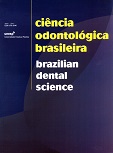Análise histomorfométrica de tecido ósseo mantido em solução fisiológica
DOI:
https://doi.org/10.14295/bds.2005.v8i1.179Abstract
O sucesso dos enxertos ósseos autógenos está relacionado à viabilidade das células transportadas para a área receptora. Durante o procedimento cirúrgico, entre a retirada do bloco ósseo da área doadora e sua colocação na área receptora, é comum que o fragmento fique algum tempo em solução fisiológica. O objetivo desse estudo foi realizar avaliação histomorfométrica da preservação de osteócitos em fragmentos de tíbia, mantidos em solução salina por diferentes períodos. Vinte e quatro fragmentos ósseos foram removidos e divididos em quatro grupos iguais. O grupo controle foi fixado em formol 10%, imediatamente após a remoção. Os demais grupos foram mantidos em solução salina por 5, 15 ou 30 minutos, antes da fixação. Em seguida, os espécimes foram descalcificados em EDTA e processados para inclusão em glicol metacrilato. Os cortes com cerca de 3μm de espessura foram corados em azul de toluidina 1%. A análise histológica foi realizada segundo critério que considerou os osteócitos como normais, alterados e lacunas (vazias). Se¬gundo análise estatística (teste de Tuckey) houve redução significativa na quantidade de osteócitos normais em todos os períodos experimentais. O número de lacunas e osteócitos alterados aumentou significativamente em todos os períodos experimentais, exceto em 5 minutos. Segundo os resultados, ocorre redução progressiva da quantidade de osteócitos em fragmentos ósseos de tíbia de coelhos mantidos em solução salina.Downloads
Downloads
Published
How to Cite
Issue
Section
License
Brazilian Dental Science uses the Creative Commons (CC-BY 4.0) license, thus preserving the integrity of articles in an open access environment. The journal allows the author to retain publishing rights without restrictions.
=================




























